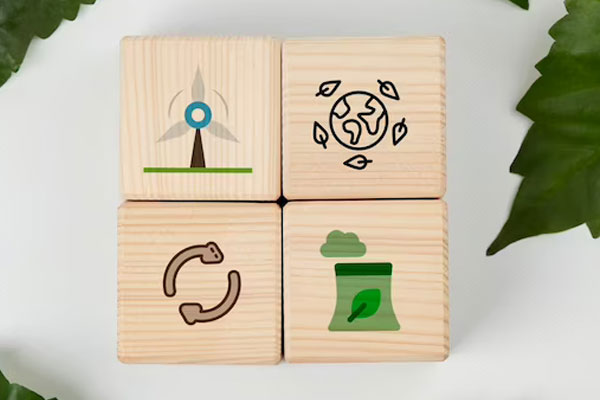Nowadays, the construction industry is placing increasing importance on the use of sustainable supplies and equipment. One of the challenges industry professionals face is selecting environmentally friendly building materials that also fit their projects’ needs.
In this article we will explore how to choose sustainable building materials. Here below, you will find lists of sustainable supplies organized according to their use on construction sites. With this guide, you can make sure that the construction materials you use help to reduce environmental impact.
Sustainable Wood for Construction
Sustainable woods are a popular choice for eco-friendly construction due to their renewable origin and low carbon footprint. These woods are sourced from sustainably managed forests and contribute to forest conservation. They are widely used in cladding, flooring, furniture, and structures.
| Wood Material | Common uses |
|---|---|
| Bamboo | Cladding, flooring, furniture, structures |
| Cedar | Cladding, pergola construction |
| Pine | Structures, door and window frames |
| Spruce | Cladding, furniture construction |
| Oak | Floors, beams, furniture |
| Teak | Floors, exterior cladding |
| Beech | Furniture, wall panels, floors |
| Birch | Furniture, cabinets, cladding |
Sustainable Cladding Materials
Sustainable cladding materials offer an eco-friendly alternative to conventional products. These materials are made from renewable and recycled resources and can reduce dependence on non-renewable materials. They are employed to enhance and safeguard both the outer and inner surfaces of buildings.
| Cladding Material | Common Uses |
|---|---|
| Recycled wood | Wall coverings, decorative panels |
| Fiber cement panels | Exterior cladding, facades |
| Adobe bricks | Cladding, wall construction |
| Straw tiles | Roof cladding, rural structures |
| Bamboo panels | Wall cladding, ceilings |
| Cork boards | Wall cladding, acoustic insulation |
Ecological Insulation and Bioconstruction
Ecological insulation plays a crucial role in enhancing energy efficiency and minimizing energy usage within buildings. These materials minimize heat and cold loss, enhance thermal comfort, and reduce the carbon footprint. Examples of ecological insulation include cellulose fiber, hemp, sheep wool, and cork panels.
| Ecological Isolation | Common Uses |
|---|---|
| Recycled cellulose fiber | Walls, ceilings, attics |
| Sheep wool | Walls, ceilings, floors |
| Hemp fiber | Thermal and acoustic insulation |
| Cork panels | Walls, ceilings, floors, acoustic insulation |
| Straw insulation | Walls, ceilings, rural constructions |
Sustainable Roofing and Shingles
Sustainable roofing and shingle materials offer durability, weather resistance, and energy savings. These materials help reduce building thermal load, decrease energy consumption, and promote rainwater collection. Common examples include solar shingles, green roofs, ceramic tiles, and natural slate shingles.
| Sustainable Roofing and Shingles | Common Uses |
|---|---|
| Solar shingles | Renewable energy generation |
| Green roofs | Improved insulation, water collection |
| Ceramic tiles | Durable, weather-resistant |
| Natural slate shingles | Good aesthetic appeal, weather resistance |
Ecological Paints and Coatings
Ecological paints and coatings provide a sustainable option to enhance and protect interior and exterior building surfaces. These products have low levels of volatile organic compounds (VOCs) and reduce the release of toxic substances into the air. Options include water-based paints, milk paints, and clay and lime coatings.
| Ecological Paints and Coatings | Common Uses |
|---|---|
| Water-based paints | Interior and exterior walls |
| Milk paints | Walls, furniture, wood surfaces |
| Clay coatings | Wall cladding, interior finishes |
| Lime coatings | Exterior cladding, stucco, concrete surfaces |
Sustainable Structural Building Materials
Sustainable structural building materials offer strength, durability, and stability to constructions. These materials are designed to have a low environmental impact during production and may include options such as low-carbon concrete, recycled steel, and laminated wood structural systems.
| Sustainable Structural Building Materials | Common Uses |
|---|---|
| Low-carbon concrete | Foundations, building structures |
| Recycled steel | Door and window frames, structures |
| Glued laminated wood | Beams, columns, roof structures |
| Compressed earth blocks | Walls, low-rise constructions |
Sustainable Water and Gas Pipes
Sustainable water and gas pipes focus on minimizing water waste and reducing the carbon footprint associated with the supply and distribution of these services. Options include lead-free PVC pipes, high-density polyethylene (HDPE) pipes for underground applications, and recycled copper pipes.
| Sustainable Water and Gas Pipes | Common Uses |
|---|---|
| Lead-free PVC pipes | Potable water supply, drainage |
| High-density polyethylene (HDPE) pipes | Water and gas in underground applications |
| Recycled copper pipes | Potable water supply, gas, heating |
Sustainable Electrical Materials
Sustainable electrical materials aim to reduce energy consumption and promote efficiency in building electrical systems. These materials can include recycled copper cables, low-energy consumption switches and outlets, and LED lighting systems.
| Sustainable Electrical Materials | Common Uses |
|---|---|
| Recycled copper cables | Electricity conduction |
| Low-energy consumption switches and outlets | Electrical system control |
| LED lighting systems | Efficient and low-energy lighting |
Building a Greener World
Sustainable construction has become a priority to promote a greener future and reduce the environmental impact of our buildings. By utilizing sustainable construction materials in different categories such as wood, cladding, insulation, roofing, paints, structural building materials, water and gas pipes, and electrical materials, we can create more efficient, durable, and environmentally-friendly buildings. By choosing these materials, we contribute to environmental protection and the well-being of future generations.
Want to learn more about how to develop green and environmentally friendly buildings? Continue reading our articles on saving energy resources in construction and energy efficiency KPIS.

